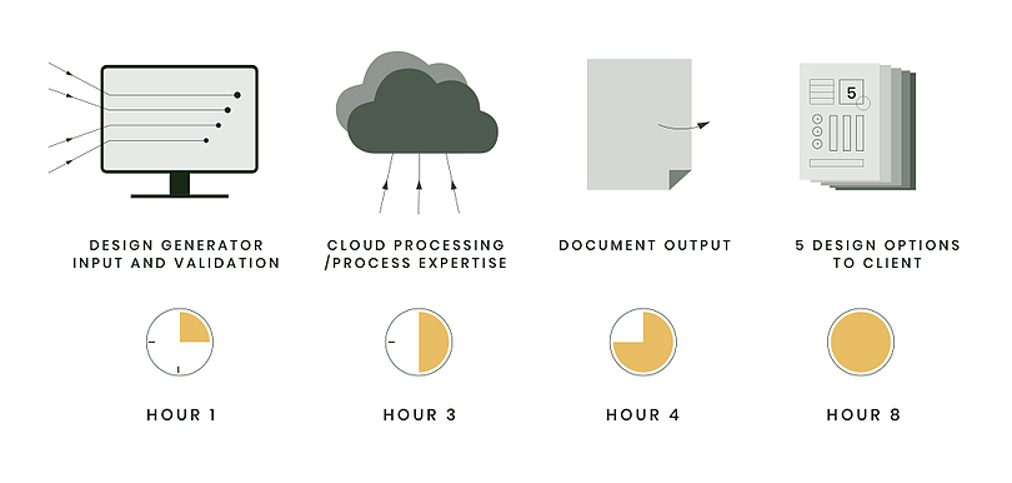
After twelve months of collaborating with your consulting engineer, you’ve finished your utility’s wastewater treatment master plan. Relief. Then, right as it’s behind you, your town is chosen as one of the best places to live in the country. The population boom voids your new master plan. Your staff, management, and town hall are tense as budgets shuffle and the process starts again. You can’t help but wonder, “There has to be a better way.”
Enter AI & Generative Design
Artificial Intelligence & Generative Design are rapidly evolving fields, constantly pushing the boundaries of engineering innovation. As technology and computing capabilities advance with each passing day, so too do the tools available to capital planners, engineers, & designers.
According to Autodesk, Generative design is a design exploration process. Designers or engineers input design goals into the generative design software, along with parameters such as performance or spatial requirements, materials, manufacturing methods, and cost constraints. The software explores all the possible permutations of a solution, quickly generating design alternatives. It tests and learns from each iteration what works and what doesn’t.
Software can generatively design multiple options for an entire wastewater treatment plant by providing basic project parameters like chemical oxygen demand (COD), Biochemical oxygen demand (BOD), Total suspended solids (TSS), flow, treatment technology, and a site plan.
Artificial intelligence is a technology that involves the use of algorithms to optimize designs using engineering rules of thumb and ‘intelligent’, rules based, heuristics.
AI coupled with generative design can not only design an entire wastewater treatment plant without human intervention, but optimally arrange assets and buildings on a given site based on the constraints a user provides.
As AI applications within generative design continue to develop, the potential uses in multiple industries, and especially water/wastewater, have become more apparent. Generative design can revolutionize the process of engineering design and enable design-build teams to create complex, optimized treatment works with a fraction of the manual effort that was once required – as early as the conceptual design phase.

Combining AI and Generative Design are key for design-build teams at the outset of the project
In traditional engineering design, the process of designing a treatment works is often linear (process -> mechanical -> electric -> civil), time-consuming, and labor intensive. This can be due to the need for designs to adhere to specific criteria (i.e. regulatory requirements, CAPEX, OPEX, etc.) and be agreed upon by all stakeholders before they become final.
Additionally, depending on the complexity of the product in question, an engineer may have to go through several design iterations before they arrive at the final product. Further, the process is limited by how many creative design iterations an engineer can come up with in a given time, limiting the potential of design innovation and optimization.
Overall, this entire process is often expensive and time-consuming with no guarantee that the final concept design will meet the desired criteria by all project stakeholders.
Generative Design to The Rescue
Generative design tools overcome many of these issues by automating much of the conceptual design process. Through generative design software, engineers can quickly create a variety of designs while still adhering to specific criteria and optimizing their projects for performance in the conceptual design phase of a project.

Generative design software uses generative algorithms to create a range of possible solutions for a given set of criteria, allowing engineers to select the ideal design in a fraction of the time, improving the project management process.
This is changing the landscape of the AEC industry by creating more innovative, cost-effective designs early on in project phases. By focusing on the outcome, architects, engineers, and other stakeholders can create projects that meet the needs of all stakeholders and achieve the optimal outcome for everyone involved from the very beginning of the project, rather than the end.
Let’s look at a few examples of how generative design and AI are solving some of the key challenges in Design-Build projects.
The Client, Contractor, Suppliers, and Engineering Stakeholders Are Integrated Into the Process
The outcome-based design process creates more collaboration and communication between all stakeholders. Each stakeholder has a say in the outcome of the project from the very beginning, which helps to ensure that everyone is on the same page and working towards the same outcome. Plus, since they come from varying backgrounds, they each bring unique perspectives and insights to the design process. From project planning to construction, to design reviews and implementation – generative design leads to outcomes early on in the process and provides an opportunity for all stakeholders to be involved in the project.
Lower Cost Of Design
Because design-build teams can track and monitor multiple outcomes in real time, they can make adjustments quickly and efficiently. There are countless cycles and iterations required in traditional design processes, but generative designs can be optimized and sped up significantly – reducing time constraints and enabling projects to come in under time (and ideally under budget).
The generative design process also helps to reduce the cost of design as teams can identify potential problems early on and make adjustments before it’s too late. This helps to reduce the amount of time and money spent on projects, resulting in a more optimal project outcome.
More Satisfied Stakeholders
The outcome-based design process also helps to create more satisfied stakeholders. Involving all stakeholders in the design process ensures that everyone’s needs are being met and that everyone is working towards a common outcome. Imagine having a complete 30% design for multiple treatment options in hours rather than weeks or months, including full BIM files and associated documents in the conceptual design phase!
Case Study: 30 concepts for a 24 MGD treatment plant
For example, Transcend transformed a large southern U.S. utility’s WRRF capital planning process. As stricter effluent limits collide with high-power weather events and population growth in North Texas, the utility needed to consider alternative technologies that could address their future constraints. But time and money restricted their considerations. After learning how the Transcend Design Generator, a generative design tool for treatment works, could empower consultants to offer 30 scenarios instead of three, they amended their RFP. Transcend gave technical support to the bidding consultants and the utility received ten times the options for their master plan, with no change to the timeline or budget. After reviewing the options and choosing a consultant, the utility could move on to cutting-edge designs they previously couldn’t consider.
Generative design and AI are here to stay
Utilities, their consultants, and the engineers that work on these projects are dealing with unpredictable demands, shorter deadlines, and tighter budgets. Advanced tools like generative design platforms & optimized decisions with AI allow these teams to meet project objectives earlier on the process – both under time and under budget.
Consider using tools like these during your next treatment works project.
